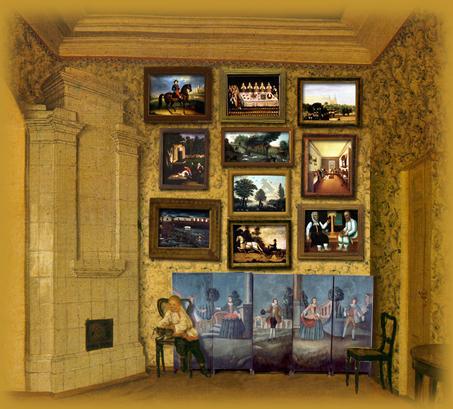Russian provincial genre painting was rather diverse: one part of it was close to the academic art, another was tightly attached to the folk art. It was natural: so diverse was the artistic level of the painters, so different were social classes, which the customers of this art belonged to: noblemen, merchants, petty-bourgeois…
It is not surprising that the notions of the kinds of painting appropriate to adorn the house were also diverse. "I've got, - [says the artist], - "Venetian Robber", who's murdering a baby, and I've got "Italian Morning", and also the Governor's portrait. Didn't take the risk to get the robber. The position didn't allow…Being in charge of the tsar's household. A robber would appear in tsar's sight? Although a foreign, still not worth. Moreover, the wife is heavy every year, what if she looks at the "Robber" in her later days and gets horrified… To get the portrait, I fear, it wouldn't suit to my position and people would laugh at me: "Such a frail, a provincial attorney, acquired the portrait of His Excellency". Give me, I tell him, "Italian Morning". <…> When I got it home, unwrapped and put it on the table, I couldn't help whacking… What a shame, Karl Ivanovich! A married man and to have such a trash! There's not a morning on the picture at all, but a young girl standing in an under-shirt, washing hands, with bare shoulders, everything naked, crumpled bed near-by. And all the rest, trivial - also here! Hung it. Soon I began to notice that my Katerina Vasilievna had become gloomy; every time passing by the drawing-room she spat upon. Sometimes she even sobbed. Whenever I tried to talk to her tenderly, she responded: "Go to the drawing-room, there's your "Italian Morning"" (P.Mel'nikov-Pechersky, "Imeninny pirog" - "Birthday Cake").
However what was unsuitable for a wife of a low-rank clerk could well be appropriate to an emancipated woman who lived in a free life-style. "On the chest [in the florist's drawing-room] there are gilded porcelain cups and alabaster busts: of Pushkin, Napoleon and a parrot. On the wall there are pictures hanging: portrait of the hostess in the morning dishabille with a sweet smile; lower is a silhouette of an unknown man cut of the black paper, on the sides in paper mounts there are four seasons and some woman withthe forms too open, putting on a stocking, with an inscription at the bottom: Morning, and another one naked woman sitting with a man beneath the tree, inscribed - That's what you did to me!" (P. Wistenhoff, "Ocherki moskovskoy zhizni" - "Sketches of Moscow Life").
Not less important was the interior: what was not suitable in the drawing-room could well fit in the pub decoration. "Every visitor is aware what all these public halls are like: the same paintings of the wall-size, on one picture is depicted a nymph with such a huge breast, that a reader might not ever been able to see." (N.Gogol', "Mertvye dushi" -" The Dead Souls").
